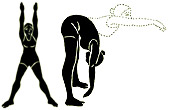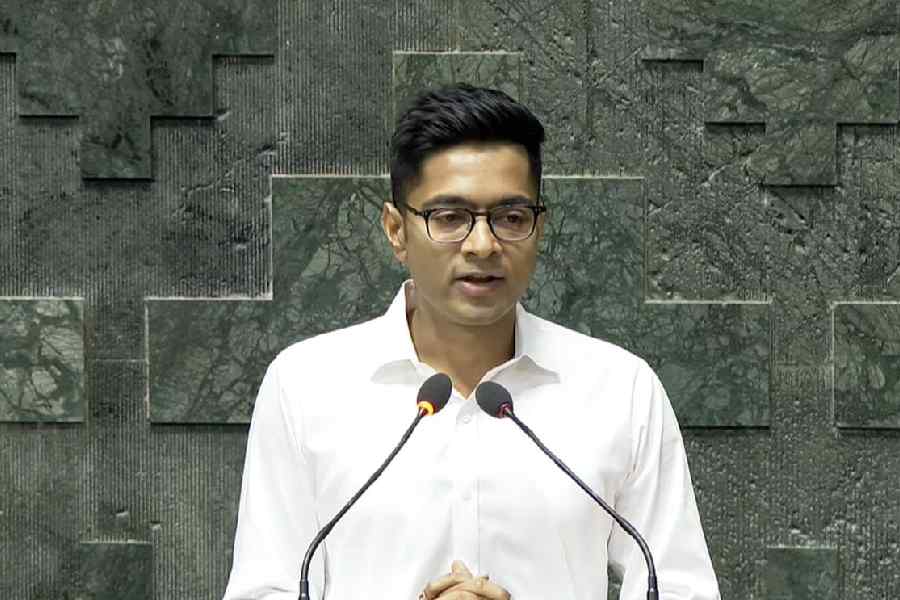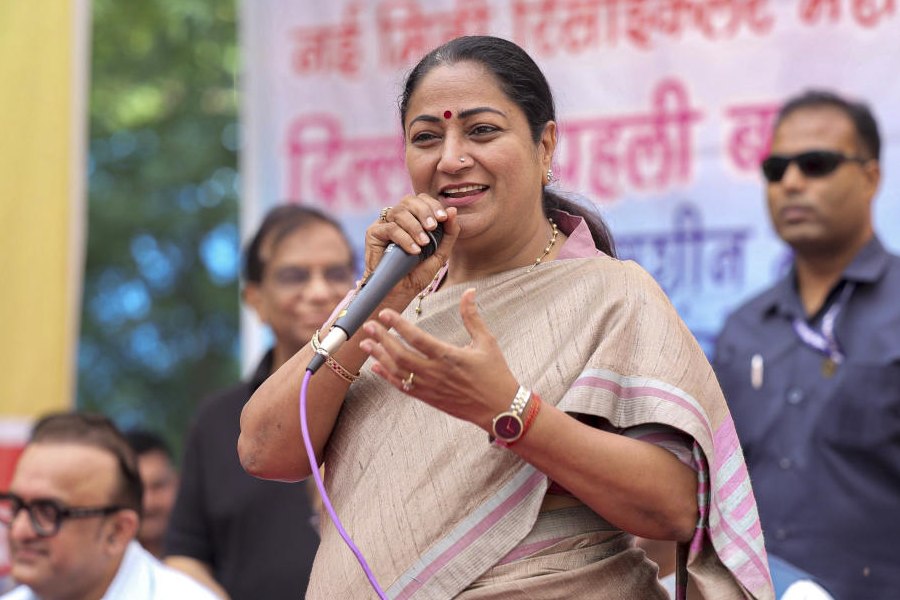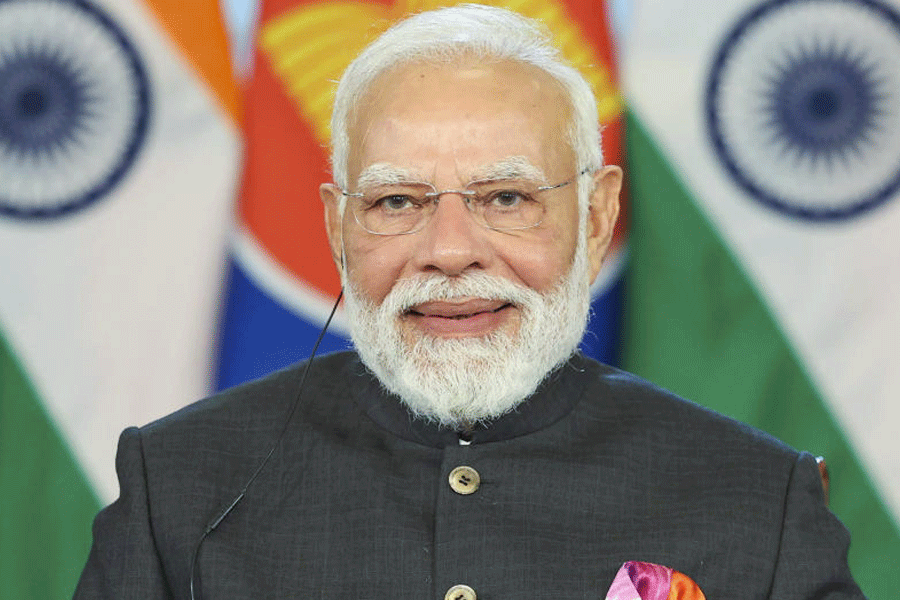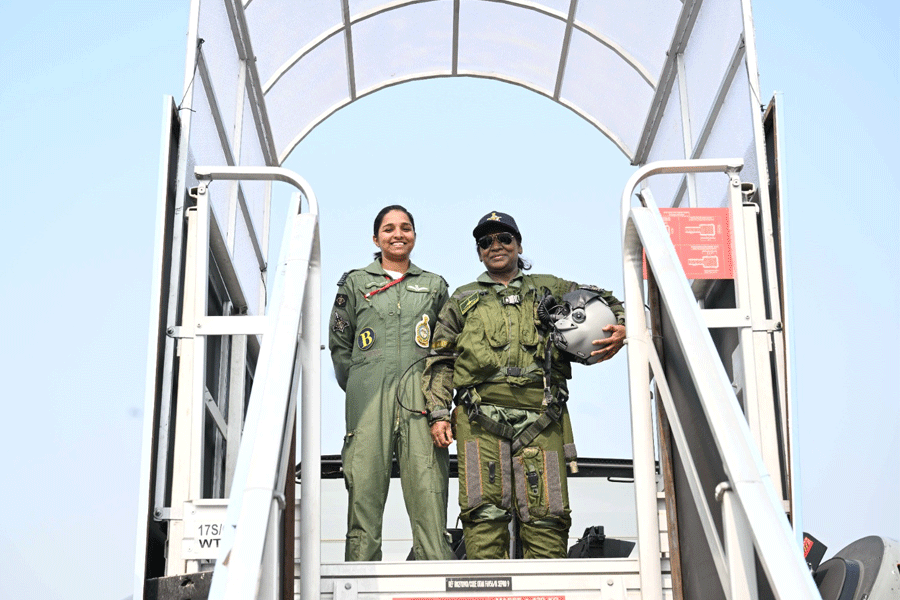| Yogic asanas are both static and dynamic. The dynamic movement of the body is accompanied by a breathing rhythm or pattern. Asanas performed with correct breathing pattern makes the posture more beneficial than those performed without the breath. Correct breathing checks the habitual wandering of the mind. Through rhythmic breathing, the oxygen intake of the body is increased. As a result, the entire body’s functioning is improved. This month’s capsule has practices that aim at establishing a rhythm in the normal breathing process. It aims at increasing the breathing capacity. The practices for this month are as follows. | |
| 1. UTTHITA LOLASANA (swinging while standing pose) | |
Stand erect with the feet a metre apart. Raise the arms overhead keeping the elbow straight. Bend your wrists forward so that the hands hang limp. Bend forward and swing the trunk down from the hips, allowing the arms and head to swing through the legs. On the upward swing, raise the trunk so that it is parallel to the floor. On the downward swing, bring the hands as far back as possible behind the feet. After completing 10 swings return to the upright position. Repeat upto five times. | |
| BREATHING: Inhale fully when you are raising the arms and while returning to the upright position. Exhale forcefully through the mouth on each downward swing. While swinging up, slight inhalation will be a minor reflex action only, but the main object is to empty the lungs totally on the downward swing. For added effect, the sound ‘ha’ may be made with each forced exhalation. This sound should come from the mouth. | |
| CONTRAINDICATION: Not to be practised by people who suffer from vertigo, high blood pressure or back problems. | |
| BENEFITS: Removes tiredness, stimulates and tones the spinal nerves, stretches the hamstring and the back muscles, loosens the hips and massages the visceral organs; it is an excellent pre-pranayama practice as it opens up the alveoli and balances the ventilation-perfusion matching in the lungs; the asana also benefits the brain. | |
| 2. HASTA UTTHANASANA (hand raising pose) | |
Stand erect with your feet together and the arms by the sides. Balance your body weight equally on both the feet. Cross the hands in front of the body. Inhale deeply and slowly raise the arms above the head, keeping the hands crossed. Synchronise the movements with the breath. At the same time, bend the head slightly backwards and look up at the hands. Exhale and spread the arms out to the sides so that they form a straight line at shoulder level. Inhale and reverse the movement, re-crossing the arms above the head. Exhale and lower the arms straight in the front of the body so that they are once again in the starting position. Repeat the process 10 to 15 times. | |
| BENEFITS: Rectifies rounded shoulders, removes stiffness from shoulders and upper back, improves breathing capacity. | |
| 3. VAYU NISHKASANA (wind releasing pose) | |
Sit in squatting position with your feet about two feet apart. Grasp the insteps of your feet, placing the fingers under the soles with the thumbs above. The upper arms should be pressing against the inside of your knees with the elbows slightly bent. Inhale while moving your head back. Direct your gaze upward. This is the starting position. Hold your breath for three seconds, accentuating the backward movement of the head. While exhaling straighten your knees, raise the buttocks and bring your head forward towards the knees. Hold your breath for three seconds, accentuating the spinal bend. Breathing in, return to the starting position. This is one round. Practise eight to 12 rounds. | |
| BENEFITS: Has a beneficial effect on the nerves of the thighs, knees, shoulders, arms and neck, pelvic organs and muscles are massaged, stretches the whole spine, and relieves flatulence. | |
| 4. UTTHANPADASANA (raised legs pose) | |
Lie in the base position with your palms flat on the floor. Inhale and raise the right leg as high as comfortable keeping it straight and the foot relaxed. The left leg should remain straight and in contact with the floor. Hold the posture for three to five seconds. Exhale and slowly lower the leg to the floor. This is one round. Practise five rounds with the right leg and five with the left leg. This can be repeated raising both legs together. | |
| BENEFITS: Strengthens the abdominal muscles and massages the organs, improves digestion, strengthens lower back, perineal, and pelvic muscles. | |
| 5. BHUJANGASANA (cobra pose) | |
Lie flat on the floor with the legs straight, feet together and the soles of the feet uppermost. Place the palms flat on the floor, below and slightly to the sides of the shoulders. The fingers should be together and pointing forward. The arms should be positioned so that the elbows point backward and are close to the sides of the body. Rest the forehead on the floor and close the eyes. Slowly raise the head, neck, and the shoulders. Straightening your elbows, raise the trunk as much as possible using the back muscle more than the arm muscle. Be sure you are using the back muscle first while starting to raise the trunk. Then use the arm muscle to raise the trunk further and arch the back. Gently tilt the head backward , so that the chin points forward and the back of the neck is compressed. In the final position, the pubic bone remains in contact with the floor and the navel is raised a maximum of three centimetres. The arms may or may not be straight; this will depend on the flexibility of the back. Hold the final position. To return to the starting position, slowly bring the head forward, release the upper back by bending the arms, lower the navel, chest, shoulders and finally the forehead to the floor. Relax the lower back muscles. | |
| BREATHING: Inhale while raising the torso. Breathe normally in the final position or retain the breath if the pose is held for a short time. Exhale while lowering the torso. | |
| CONTRAINDICATION: People suffering from peptic ulcer, hernia, intestinal tuberculosis or hyperthyroidism should not practise this asana without expert guidance. | |
| BENEFITS: It helps relocate slipped disc, removes backache, keeps the spine healthy, tones ovaries and uterus and helps to alleviate menstrual and gynaecological disorders, it stimulates the appetite, alleviates constipation and is beneficial to all abdominal organs. It stimulates and massages the adrenal glands, and regulates the thyroid gland. | |
| 6.YOGIC BREATHING | |
Sit in a meditation posture or lie down in Shavasana and relax the whole body. Inhale deeply, allowing the abdomen to expand fully. Feel the air reaching into the bottom of the lungs. At the end of abdominal expansion, start to expand the chest outward and upward. When the ribs are fully expanded, inhale a little more until expansion is felt in the upper portion of the lungs around the base of the neck. The shoulders and collar bone should also move up slightly. Some tension will be felt in the neck muscles. The rest of the body should be relaxed. Feel the air filling the upper lobes of the lungs. This completes one inhalation. The whole process should be one continuous movement. There should be no jerks or unnecessary strain. During exhalation , relax the lower neck and upper chest, then allow the chest to contract downward and inward. Next allow the diaphragm to push upward and toward the chest. Without straining, try to empty the lungs by drawing or pulling the abdominal wall as near as possible to the spine. The entire movement should be harmonious and flowing. Hold the breath at the end of each exhalation. This completes one round of yogic breathing. Perform 25 to 30 rounds. | |
| BENEFITS: It is used to maximise inhalation and exhalation, correct poor breathing habits and increase the intake of oxygen, helps to manage high stress and anger by calming the nerves. The practices should be performed in the following sequence Surya Namaskar (salutation to the sun); |
 Thursday, 30 October 2025
Thursday, 30 October 2025
